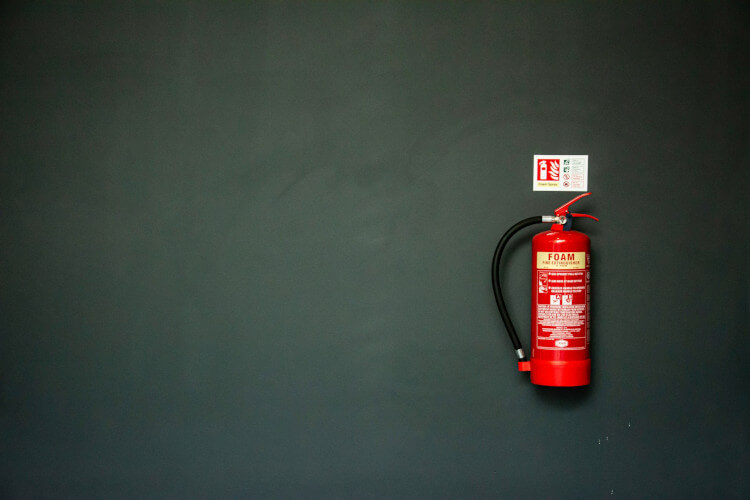
Fire extinguishers are essential components of a robust fire protection plan. Different fires will require different types of fire extinguishers, so it’s important to understand the difference between them. This blog explains the various classes of fire and the types of fire extinguishers needed to put them out.
Classes of fire
Fires can be categorised by the following characteristics:
- Class A – Fires involving combustible organic materials such as wood and textiles.
- Class B – Fires involving flammable liquids like paint and petrol.
- Class C – Fires involving flammable gases including carbon monoxide.
- Class D – Fires involving flammable metals such as lithium.
- Electrical fires – Fires involving electrical equipment like computers.
- Class F – Fires involving cooking oils.
Fire extinguisher types
There are four main types of fire extinguisher:
- Water fire extinguishers
- Foam fire extinguishers
- CO2 fire extinguishers
- Dry powder fire extinguishers
Let’s take a closer look at how each one works…
1. Water fire extinguishers
Water fire extinguishers quickly cool the fuel source and remove heat from the fire, making it impossible for it to burn.
There are lots of environments where a water fire extinguisher would be essential. These include:
- Any buildings that consist of organic materials such as wood
- Any space where organic materials are found (such as homes, hospitals, offices, etc.)
When to use water extinguishers
Water fire extinguishers are only suitable for class A fires involving combustible organic materials such as wood, paper and fabrics.
When not to use water extinguishers
You must never use a water fire extinguisher for electrical fires, kitchen fires or fires involving flammable liquids/gases.
2. Foam fire extinguishers
Foam fire extinguishers smother the fire by creating a blanket that separates the flames from the fuel source. The foam also cools the flames, removing heat from the fire.
Foam extinguishers should be used in warehouses, schools and any premises where flammable liquids may be stored. They shouldn’t be used in domestic environments.
When to use foam extinguishers
Foam fire extinguishers are only suitable for class A fires (combustible organic materials) and class B fires (flammable liquids). Flammable liquids include paint, petrol, aerosol sprays, etc.
When not to use foam extinguishers
Do not use foam fire extinguishers to put out fires involving flammable metals, electrical fires or kitchen fires.
3. CO2 fire extinguishers
A fire requires oxygen to keep burning. CO2 fire extinguishers work by displacing that oxygen, essentially suffocating the fire. Additionally, the CO2 gas is very cold, so it also cools the fuel source.
CO2 is stored within the extinguisher as a liquid, but it is discharged as a gas due to the pressure created when the handle is squeezed.
When to use CO2 extinguishers
CO2 fire extinguishers are suitable for class B fires (flammable liquids) and electrical fires (high and low voltage).
When not to use CO2 extinguishers
CO2 extinguishers are not safe for kitchen fires, flammable metals or organic materials such as paper or wood.
4. Dry powder fire extinguishers
Dry powder fire extinguishers create a barrier between the oxygen source and the fuel source, smothering the fire. Unlike most other fire extinguisher types, dry powder does not cool the fire, so there is a chance that it could reignite.
You’re most likely to see this type of fire extinguisher in environments where flammable gases are used for chemical processes, or in buildings with large boiler rooms.
When to use dry powder extinguishers
Dry powder fire extinguishers can be used in a wide range of environments and scenarios. They are suitable for putting out class A, class Band class C fires, as well as fires involving electrical equipment (safe up to 1,000 volts).
When not to use dry powder extinguishers
These fire extinguishers must not be used on cooking oil fires, electrical fires over a thousand volts, or fires in enclosed spaces like homes and offices.
Fire protection at IDS
Choose IDS to install your fire protection system, including state-of-the-art alarms and fire extinguishers. We can tailor your fire protection system to suit your requirements and provide a wide range of fire extinguishers including water, foam, CO2 and dry powder.
IDS Fire Extinguishers Get a Quote